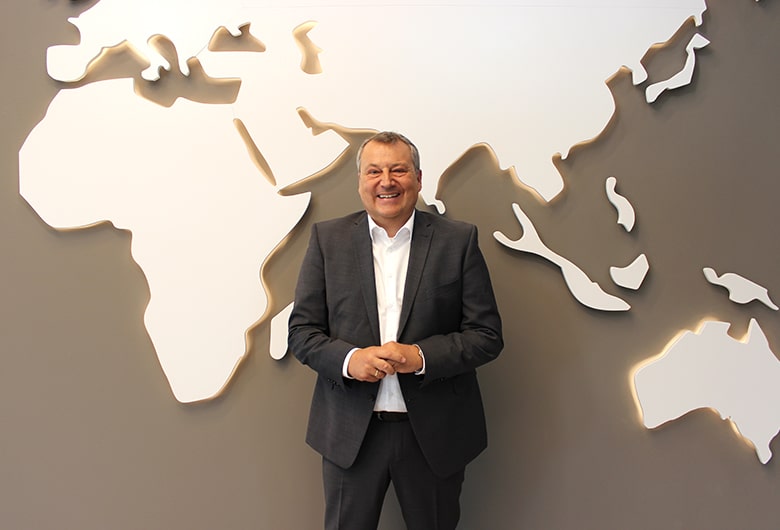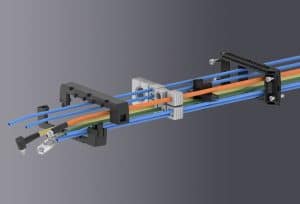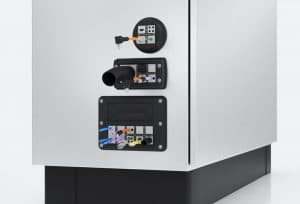
Onlangs heeft Jörg Nowastowski-Stock, Hoofd product management en lid van het bestuur, een interview gegeven in het toonaangevende Duitse magazine SCHALTSCHRANKBAU. Hieronder kunt u het artikel in het Engels lezen.
“Solutions that nobody can get past” – The big interview
 CONTA-CLIP is launching the new cable entry system KDSI-SR on the market at the Hanover Fair 2021. KDSI-SR adapts the innovative sealing technology of KDS, but with its inverse system design, it is used for equipping control cabinets from the outside. In the following interview Jörg Nowastowski-Stock, Head of Product Management at CONTA-CLIP, explains the special advantages of the inverse cable entry system and why we see ourselves as a global innovation leader in cable management systems with our range. The interview was conducted with the technical journal SCHALTSCHRANKBAU.
CONTA-CLIP is launching the new cable entry system KDSI-SR on the market at the Hanover Fair 2021. KDSI-SR adapts the innovative sealing technology of KDS, but with its inverse system design, it is used for equipping control cabinets from the outside. In the following interview Jörg Nowastowski-Stock, Head of Product Management at CONTA-CLIP, explains the special advantages of the inverse cable entry system and why we see ourselves as a global innovation leader in cable management systems with our range. The interview was conducted with the technical journal SCHALTSCHRANKBAU.
Mr. Nowastowski-Stock, the cable management system KDS has been an excellent success for CONTA-CLIP. Now your company is launching KDSI-SR on the market: What is new about it?
 Jörg Nowastowski-Stock: At KDS, the assembly and sealing take place from the inside of the housing. For KDSI-SR, we have adapted the essential innovations that we first introduced with KDS, but the system for mounting outside the housing is designed inversely. It sounds simple at first but placed entirely different demands on the frame design and sealing technology development.
Jörg Nowastowski-Stock: At KDS, the assembly and sealing take place from the inside of the housing. For KDSI-SR, we have adapted the essential innovations that we first introduced with KDS, but the system for mounting outside the housing is designed inversely. It sounds simple at first but placed entirely different demands on the frame design and sealing technology development.
Can you explain this in more detail?
Jörg Nowastowski-Stock: At KDS-Click, the idea of developing a quick-to-install, perfectly sealing cable entry solution that avoids the shortcomings of conventional sealing systems was central for us. Our primary focus was on maximum compatibility with different cable or hose diameters and the option of adapting the configuration at any time without time-consuming frame disassembly. The aim was to achieve this with a modular design and a small number of system components, requiring only a few hand movements and without the use of tools. We have succeeded in this in an effective and successful manner: There is currently no other cable entry system on the market that is so simple and provides such reliable sealing for all requirements. To implement all the advantages mentioned above at KDS, we designed the system for insertion from the inside of the housing and we have managed to solve several issues with one action. With this design, the strain relief to the outside is given almost automatically. For mounting scenarios where the cable entry system’s external mounting is, required we now complete our range with KDSI. The “I” in the abbreviation refers to the inverse structure of the solution.
In which cases is the external equipment necessary?
Jörg Nowastowski-Stock: KDS is based on control cabinets, machine frames or other installation conditions that leave enough space to slide the sealing elements for cable sheathing from the inside of the housing into the system frame. However, in smaller distribution cabinets, densely packed internals or cable ducts that obstruct the housing openings for the feed-through frames can hinder the simple procedure. With KDSI, we are following the traditional method of installing cable glands from the outside – with the big difference, however, with our system, nothing is screwed on, but only pushed in. The additional benefit is, KDSI has dimensions that fit both the housing openings required for KDS and standard cut-outs for heavy duty industrial connectors.
“For installation scenarios where, however, external installation of the cable entry system is necessary or desired, we now complete our range with KDSI. The “I” in the abbreviation refers to the inverse structure of the solution.”
What are the design features of KDSI’s inverse structure?

Jörg Nowastowski-Stock: For the external equipment, we had to rethink the design of the mounting frame, and more precisely the strain relief. While this is self-evident with KDS due to fitting the conical sealing elements from the inside, the insertion from the outside required an additional measures and the 180° rotation of the conical frame guides for inlays and sealing elements to secure their tight fit under tension. We solved this with a frame cover to cover and fix the sealing parts, which is then snapped onto the frame. KDSI is assembled and installed in the same way as KDS, but from the outside of the housing. The central extension of KDSI consists of the cover, the halves of which are then placed around the cable harnesses, locked together, and then snapped onto the frame. As an additional effect, the frame cover also covers the frame mounting screws, providing a clean visual appearance to the product. It also represents a hygiene advantage depending on the application. Since we placed great importance on convenient and straightforward installation throughout the frame design, we had to invest a great deal of design expertise. This applies especially to the consideration of three sealing levels.
In what way was waterproofing a challenge?
Jörg Nowastowski-Stock: Unlike other products, our cable management systems have injected captive TPE seals. Therefore, they guarantee a secure seal per IP66 on any surface and cannot slip or be accidentally forgotten. That considerably simplifies frame assembly and disassembly. Besides, time-consuming preparations required for gluing on separate foam rubber frame seals are no longer necessary. To implement this proven design, there is an additional benefit due to the sealing towards the frame in that the TPE seal exerts a spring force on the mounted bonnet from the inside. If the snap-on bonnet is to be removed for subsequent adjustments to the feed-through combination, light pressure on its removal openings is sufficient. A further innovation concerns the honeycomb structure of the bonnet plastic, giving the moulded parts increased stability against mechanical effects and thermally induced distortion.
Your company has established and expanded the new Cable Management Systems Division in a short time. What brought about this change of focus for a traditional terminal block manufacturer like CONTA-CLIP?
Jörg Nowastowski-Stock: We do not see this as a change of focus but an essential diversification of our product range. For CONTA-CLIP, modular terminal blocks are a fundamental part of our business and will remain so. We are very proud and satisfied with the rapid expansion of our new division within about three years. We see our mission in supplying connection technology and accessories that enable the customer to wire reliably and as quickly as possible. The time advantage has become a key factor and a decisive sales argument for installation material – whether it is terminals or cable management. The path from the terminal to the housing – i.e. from the entry to the feed-through – was almost inevitable for us. For a long time now, we have also been offering solutions for cables’ shield connection in our extensive SAB program, distributing wiring ducts, cable glands, and, last but not least, a comprehensive range of enclosures. Even then, secure sealing became an essential issue for us. While thinking about how to avoid the typical shortcomings of conventional feed-through systems, we came up with the idea for KDSClick. When we then found out in the course of small preliminary researches how great the potential demand for such a pre-configurable feed-through was, we seized the opportunity from 2017 onwards to expand our core business with an original unique selling point.
“In the field of cable management, we can justifiably call ourselves a global innovation leader. (…) I am convinced that with our expertise and technical lead in cable management systems, we can become the market leader”.
To what extent was this important for the terminal block manufacturer CONTA-CLIP?
 Jörg Nowastowski-Stock: The terminal business is a displacement business. That means that manufacturers in this segment can only increase their market share by optimizing and refining their existing products. Still, an entirely new approach would be neither possible nor sensible. In the field of cable management, however, the situation was quite different for us. A real, as yet the unoccupied gap in the market opened up for us there. On the one hand, this allowed us to benefit from a new growth segment, and on the other hand, new products in the same field of application opened the door to the existing range. And in the field of cable management, we can justifiably call ourselves a global innovation leader.
Jörg Nowastowski-Stock: The terminal business is a displacement business. That means that manufacturers in this segment can only increase their market share by optimizing and refining their existing products. Still, an entirely new approach would be neither possible nor sensible. In the field of cable management, however, the situation was quite different for us. A real, as yet the unoccupied gap in the market opened up for us there. On the one hand, this allowed us to benefit from a new growth segment, and on the other hand, new products in the same field of application opened the door to the existing range. And in the field of cable management, we can justifiably call ourselves a global innovation leader.
What is the difference between innovation and market leader?
Jörg Nowastowski-Stock: Sales and market penetration. I am convinced that CONTA-CLIP can become the market leader with its expertise and technical lead in cable management systems. However, we still have a long way to achieve the corresponding market penetration and production capacities. On the other hand, as an innovation leader, we already offer so many fundamental designs and functional advantages with our wide range of feed-through solutions with a high degree of innovation density that nobody can ignore the quality standards we have set. Because we have chosen entirely new approaches to solutions, our products are characterized by a whole range of truly unique selling points.
For this reason, we have been able to secure internationally valid industrial property rights quickly. Moreover, these fundamental innovations have enabled us to expand our cable management program with various new developments within only three years. Today we can offer our customers the superior solution for almost all relevant implementation scenarios. This does not only apply to KDSClick and KDSI, suitable EMC connection brackets, cable glands and the special KDS ribbon cable versions, with which we have already achieved a good market position, but also to the flange plates of the KDS-FP series, with which has proved to be a very popular product . For some users, conventional feed-through systems may still be considered an alternative to KDSClick. Still, some large-format solutions for up to 30 hoses or cables comparable to KDS-FP were not even available on the market before. Figuratively speaking, this also applies to metric feed-throughs. We have introduced the principle of freely selectable seal openings with uniform frame sizes with KDS-R. Besides, we back up the range of solutions with rapid entry systems for unassembled cables from the KES-E series, which we are also continually expanding. The latest product here is the round versions of the new KES-E-R series. At the moment, there is no other manufacturer who can even come close to achieving comparable completeness of the product range in this area – and we are far from reaching the end of the line. At the moment, I don’t see a lack of ideas or other reasons that prevent us from continuing to work at this pace and developing new solutions.
Is CONTA-CLIP already considering future projects in this segment?
Jörg Nowastowski-Stock: Yes, quite a lot. For example, we are testing new design approaches for integrated EMC shielding. We are also devoting ourselves to the development of new fields of application outside of conventional factory automation. Of fundamental interest to us are all areas in which cable harnesses have to be laid or sealed, such as in the automotive sector. The ATEX topic will also play a role for us in the future.